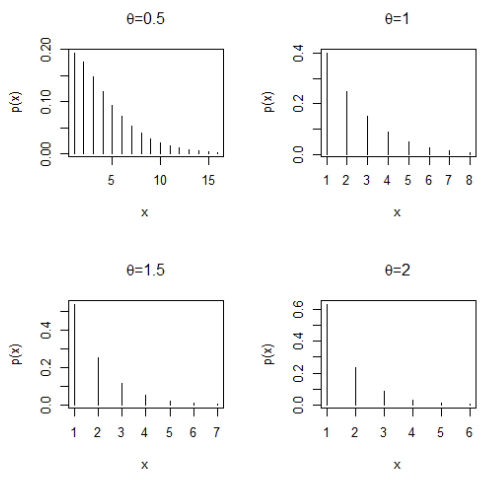Confidence Intervals using Bootstrap Methods for the Parameter of the zero-truncated Poisson-Shanker Distribution and their Application
Keywords:
interval estimation, count data, Shanker distribution, bootstrap interval, simulationAbstract
Several situations involve count data containing non-zero values and the zero-truncated Poisson-Shanker distribution can be used to model such data. However, the confidence interval estimation of the parameter has not yet been examined. In this paper, confidence interval estimation based on percentile bootstrap, simple bootstrap, biased-corrected and accelerated bootstrap, and bootstrap-t methods was examined in terms of coverage probability and average interval length via Monte Carlo simulation. The results indicate that attaining the nominal confidence level using the bootstrap methods were not possible for small sample sizes regardless of the other settings. Moreover, when the sample size was large, the performances of the methods were not substantially different. Overall, the bias-corrected and accelerated bootstrap method outperformed the others, even for small sample sizes. Last, the bootstrap methods were used to calculate the confidence interval for the parameter of the zero-truncated Poisson-Shanker distribution via three numerical examples, the results of which match those from the simulation study.
References
Akaike, H. (1973). Information theory and an extension of the maximum likelihood principle. In B. N. Petrov & B. F. Csaki (Eds.), Second International Symposium on Information Theory(pp. 267–281). Academiai Kiado: Budapest.
Chernick, M. R., & LaBudde, R. A. (2011). An Introduction to Bootstrap Methods with Applications to R. New York: John Wiley & Sons.
David, F. N., & Johnson, N. L. (1952). The truncated Poisson. Biometrics, 8(4), 275–285.
Davison, A. C., & Hinkley, D.V. (1997). Bootstrap Methods and Their Application. Cambridge: Cambridge University Press.
DiCiccio, T. J., & Efron, B. (1996). Bootstrap confidence intervals. Statistical Science, 11(3), 189–212.
Efron, B. (1982). The jackknife, the bootstrap, and other resampling plans. CBMS-NSF Regional Conference Series in Applied Mathematics, Monograph 38. SIAM.
Efron, B. (1987). Better bootstrap confidence intervals. Journal of theAmerican Statistical Association, 82(397), 171–185.
Efron, B., & Tibshirani, R. J. (1993). An Introduction to the Bootstrap. New York: Chapman and Hall.
Finney, D. J., & Varley, G. C. (1955). An example of the truncated Poisson distribution. Biometrics, 11(3), 387–394.
Flowers-Cano, R. S., Ortiz-Gómez, R., León-Jiménez, J. E., López Rivera, R., & Perera Cruz, L. A. (2018). Comparison of bootstrap confidence intervals using Monte Carlo simulations. Water, 10(2), 166. https://doi.org/10.3390/w10020166
Ghitany, M. E., Al-Mutairi, D. K., & Nadarajah, S. (2008). Zero-truncated Poisson-Lindley distribution and its application. Mathematics and Computers in Simulation, 79(3), 279–287.
Henningsen, A.,&Toomet, O. (2011).A package for maximum likelihood estimation in R. Computational Statistics, 26(3), 443–458.
Hussain, T. (2020). A zero truncated discrete distribution: Theory and applications to count data. Pakistan Journal of Statistics and Operation Research, 16(1), 167–190.
Ihaka, R., & Gentleman, R. (1996). R: A language for data analysis and graphics. Journal of Computational and Graphical Statistics, 5(3), 299–314.
Kissell, R., & Poserina, J. (2017). Optimal sports math, statistics, and fantasy. London: Academic Press.
Lindley, D. V. (1958). Fiducial distributions and Bayes’ theorem. Journal of the Royal Statistical Society: Series B, 20(1), 102–107.
Meeker, W. Q., Hahn, G. J., & Escobar, L. A. (2017). Statistical intervals: A guide for practitioners and researchers.New Jersey: John Wiley and Sons.
Manoharan, T., Arasan, J. Midi, H.,& Adam, M.B. (2017). Bootstrap intervals in the presence of left-truncation, censoring and covariates with a parametric distribution. Sains Malaysiana, 46(12), 2529–2539.
Robert, C. P., & Casella, G. (2004). Monte Carlo Statistical Methods.New York: Springer.
Ross, S. (2006). A First Course in Probability. New Jersey: Pearson Education.
Sankaran, M. (1970). The discrete Poisson-Lindley distribution. Biometrics, 26(1), 145–149.
Sangnawakij, P. (2021). Confidence interval for the parameter of the zero-truncated Poisson distribution. The Journal of Applied Science, 20(2), 13–22.
Schwarz, G. E. (1978). Estimating the dimension of a model. Annals ofStatistics, 6(2), 461–464.
Shanker, R. (2015). Shanker distribution and its applications. International Journal of Statistics and Applications, 5(6), 338–348.
Shanker, R. (2016). The discrete Poisson-Shanker distribution. Jacobs Journal of Biostatistics, 1(1), 1–7.
Shanker, R. (2017). A zero-truncated Poisson-Shanker distribution and its applications. International Journal of Statistics and Applications, 7(3), 159–169.
Shanker, R., Fesshaye, H., Sujatha, S., & Yemane, A. (2015). On zero-truncation of Poisson and Poisson-Lindley distributions and their applications. Biometrics and Biostatistics International Journal, 2(6), 168–181.
Siegel, A. F., & Wanger, M. R. (2022). Practical Business Statistics.San Diego: Academic Press.
Turhan, N. S. (2020). Karl Pearson’s chi-square tests. Educational ResearchReview, 15(9), 575–580.
Van den Boogaard, H. F. P., & Hall, M. J. (2004). The construction of confidence intervals for frequency analysis using resampling techniques: a supplementary note. Hydrology and Earth System Sciences, 8(6), 1174–1178.
Wood, M. (2004). Statistical inference using bootstrap confidence intervals. Significance, 1(4), 180–182.

Downloads
Published
License
Copyright (c) 2023 Journal of Applied Science and Emerging Technology

This work is licensed under a Creative Commons Attribution-NonCommercial-NoDerivatives 4.0 International License.

